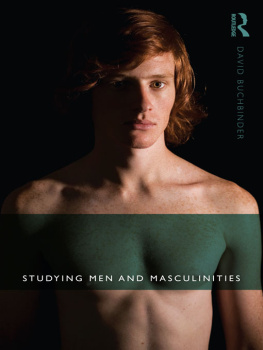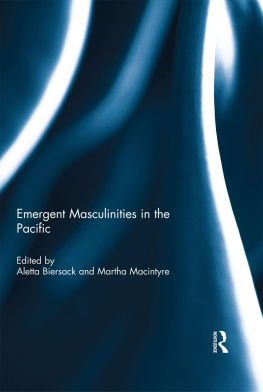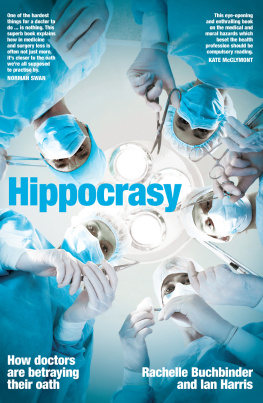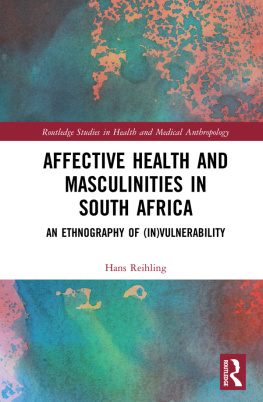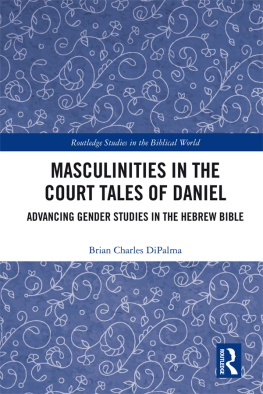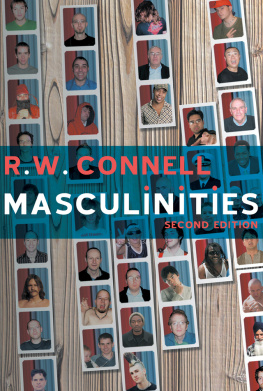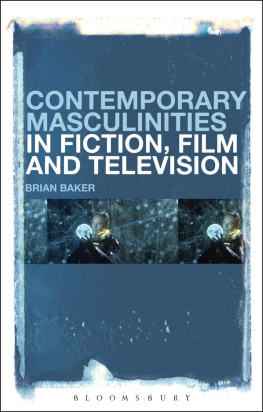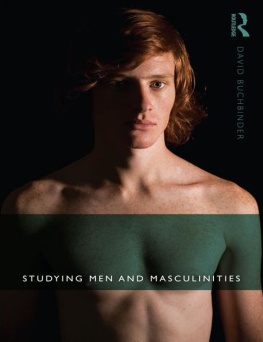Buchbinder - Studying Men and Masculinities
Here you can read online Buchbinder - Studying Men and Masculinities full text of the book (entire story) in english for free. Download pdf and epub, get meaning, cover and reviews about this ebook. City: Abingdon;UK, year: 2013, publisher: Taylor and Francis;Routledge, genre: Politics. Description of the work, (preface) as well as reviews are available. Best literature library LitArk.com created for fans of good reading and offers a wide selection of genres:
Romance novel
Science fiction
Adventure
Detective
Science
History
Home and family
Prose
Art
Politics
Computer
Non-fiction
Religion
Business
Children
Humor
Choose a favorite category and find really read worthwhile books. Enjoy immersion in the world of imagination, feel the emotions of the characters or learn something new for yourself, make an fascinating discovery.
- Book:Studying Men and Masculinities
- Author:
- Publisher:Taylor and Francis;Routledge
- Genre:
- Year:2013
- City:Abingdon;UK
- Rating:4 / 5
- Favourites:Add to favourites
- Your mark:
- 80
- 1
- 2
- 3
- 4
- 5
Studying Men and Masculinities: summary, description and annotation
We offer to read an annotation, description, summary or preface (depends on what the author of the book "Studying Men and Masculinities" wrote himself). If you haven't found the necessary information about the book — write in the comments, we will try to find it.
Studying Men and Masculinities — read online for free the complete book (whole text) full work
Below is the text of the book, divided by pages. System saving the place of the last page read, allows you to conveniently read the book "Studying Men and Masculinities" online for free, without having to search again every time where you left off. Put a bookmark, and you can go to the page where you finished reading at any time.
Font size:
Interval:
Bookmark:

.
.
Connell has published under several variations of his name, for example, R. W. Connell, Bob Connell, Robert W. Connell, and so on. More recently, as a transgender woman, she publishes under the name of Raewyn Connell.
In Roman culture, which had other words for penis (tail, in Latin), phallus more often signified an image or a carving of the penis, to be found in both profane and sacred contexts, such as a brothel and a religious procession, respectively.
The need for a man to find a best friend has become something of a theme in recent movies; for instance, the French film Mon meilleur ami ( My Best Friend ) ( My Best Friend [ Mon meilleur ami ], 2006.
One does not need to travel very far in cultural history to see a connection between Hermiones efforts to make Harry and Ron more mature and sensible, and the tendency during the nineteenth century to regard woman as a civilizing influence on man, a theme that recurs in many movie westerns, for example. This is the positive counterpart of and complement to the contemporaneous view of woman as only partially evolved, which we touch on in the next chapter.
I use this hyphenated term in order to distinguish it from the male homosexual as a social and sexual identity. Like the feminine, it signifies an attribute that functions as an abstract quality.
It is generally argued that the Deuteronomical and Levitical prescriptions and proscriptions were intended to maintain the purity of the Hebrew people, and especially of the priestly castes, against defilement, in this instance, by garments made of a mixing of two kinds of fiber: plant and animal. However, the same law might be invoked today in relation to, say, blends of silk (from an insect source) and cotton (from a plant), or silk (insect) and wool (animal) blends, or of polyester-cotton fabrics (which mix artificial and natural fibers). Were Deuteronomy 22:11 to be applied in a manner consistent with the way in which the biblical injunction against homosexual practices is continually cited, much of the clothing which we wear daily ought also to be prohibited.
In Epistemology of the Closet , Eve Kosofsky Sedgwick speaks of
the contradiction between seeing homo/heterosexual definition on the one hand as an issue of active importance primarily for a small, distinct, relatively fixed homosexual minority (what I refer to as a minoritizing view), and seeing it on the other hand as an issue of continuing, determinative importance in the lives of people across the spectrum of sexualities (what I refer to as a universalizing view).
(Sedgwick, 1990: 1)
That is, both the difference and contradiction lie in whether nonheteronormative subjects should be thought of as a distinct group, separate and different from the majority (others to the dominant) or rather as both part of and integral to the range of sexualities available to people in the culture.
Of course, women also work out in gyms. However, this motto appears to have emerged specifically in relation to mens activity in such a context. Accordingly, womens use of their bodies in workouts may be understood by some as a form of masculinization of those bodies, the extreme example of which is that of the female bodybuilder, whose muscular physique is often regarded as unfeminine and unwomanly.
Virtue should here be understood not simply as chastity, a meaning that came to be attached later to the term (so that a womans virtue signified her status either as virgin or as chaste wife), but rather as a complex of ethical principles and behaviors appropriate to living in a civil society.
It should be noted that in later Greek art these conventional representations became conflated, so that satyrs were shown with youthful athletic bodies. However, they could be distinguished from the kouroi proper by various attributes, for example, pointed ears, diminutive horns, or vestigial tail, all pointing to the animal (savage) nature of the satyr.
However, as is typical with Montaigne, the essay ends with the ironic and ambiguous comment, All this is not too bad but whats the use? They dont wear breeches (Montaigne, 1971: 159). Here are a few possible meanings: (1) the achievements of the cannibals amount finally to nothing, because they have not learned even to clothe themselves; (2) no one in Europe will pay attention to the achievements of these exotic people, because they lack the technology of clothing and are naked; (3) from the perspective of European culture, the cannibals are immoral, rather than merely innocent; (4) in the end, they are simply savages.
The complete title of the play is Almanzor and Almahide, or The Conquest of Granada by the Spaniards, a Tragedy . Almanzor speaks the following lines:
No man has more contempt than I of breath,
But whence hast thou the right to give me death?
Obeyed as sovereign by thy subjects be,
But know, that I alone am king of me.
I am as free as nature first made man,
Ere the base laws of servitude began,
When wild in woods the noble savage ran.
(Dryden, 1808: 40)
common people permitted to vent feelings in parody and play. In the example given here, the night out with the boys might be considered a moment of carnival in an otherwise controlled and disciplined existence (Bakhtin, 1984).
Kenneth R. Dutton draws attention to the Roman convention in art of the cuirasse esthtique (literally aesthetic breastplate). This breastplate, originally made of washed and molded leather ( cuir is French for leather) and later of steel, was decorated with garlands, scenes of military triumph and so on, in the same material as the breastplate itself, and was used to enhance and ennoble sculptures of notable Romans (for instance, the Emperor Augustus, various generals, and so on). Dutton points out that this cuirasse was itself modeled on the ideal muscular male upper body, irrespective of the actual physique of the man represented (Dutton, 1995: 4951). Until at least the eighteenth century, this remained a convention in visual images (painting as well as sculpture) of warriors and soldier-heroes this, despite the fact that such a breastplate, if fashioned in reality for use on the battlefield, would have been impractical, because it would have offered too many contours and crevices where a lance, sword, or pike could catch and so inflict damage, if not also actually penetrate. Here, too, the male body subtly merges into strapping, pads, and, in this instance, leather and/or metal plating. The armor of the American footballer and of his Roman antecedent serves, in fact, not only to protect the male body within the plating (notionally so, in the case of the cuirasse esthtique ) but also to fix an ideal masculine form in the cultural consciousness, a form that includes the occupation of space.
Bourdieu developed and elaborated his theory over many years, and across multiple works. Given the complexity of his thought (and of his writing), and given the scope of the present work, what follows is necessarily only a brief and partial presentation of that theory. Moreover, because of that same complexity, I rely here on the useful synoptic view offered by the various chapters in Pierre Bourdieu: key concepts (Grenfell, 2008).
Winnebago refers to the former name of a Native American people of the mid-West of the United States; the connection with the Wild West is thus inscribed in the brand name itself.
Font size:
Interval:
Bookmark:
Similar books «Studying Men and Masculinities»
Look at similar books to Studying Men and Masculinities. We have selected literature similar in name and meaning in the hope of providing readers with more options to find new, interesting, not yet read works.
Discussion, reviews of the book Studying Men and Masculinities and just readers' own opinions. Leave your comments, write what you think about the work, its meaning or the main characters. Specify what exactly you liked and what you didn't like, and why you think so.

